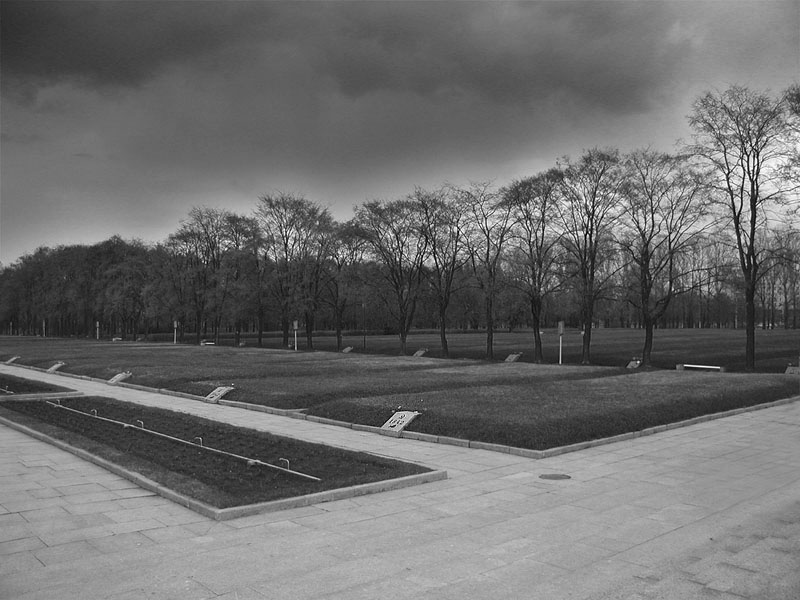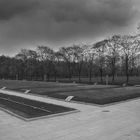Greuel des Krieges
Hier ist die eine Hälfte des Piskarjowskoje-Friedhofes in St. Petersburg zu sehen, Gräber soweit das Auge reicht und links des Mittelganges noch einmal das selbe. Auf diesem Friedhof sind die Opfer der 900tägigen Blockade des damaligen Leningrad beigesetzt. Aufgrund der riesigen Zahl der Opfer (mehr als 1 Million) fand die Beisetzung in Massengräbern statt, in jedem dieser Hügel liegen meines Wissens nach 1500 Leute.
Ich verstehe nicht wie sich Menschen so etwas antun können und hoffe zutiefst daß irgendwann einmal Frieden herrscht.










Regina Noack 29/01/2004 11:46
Yesterday my mother-in-law, who is staying with us for a three month'sholiday - as always during winter - was a little bit depressed. The
reason was that yesterday, 27th of January, was the 60th birthday of the
end of the siege of Leningrad. On 8 September 1941, the Germans reached
Leningrad. Instead of trying to overwhelm the city, like they would do
with Stalingrad, they closed it off from the rest of the city. Only 900
days later could the siege be lifted. All that time, there were
virtually no roads leading in or out of the city. One would think that
the lifting of the siege would be a happy celebration. But for those who
lived through it, like my mother-in-law, it brougth back memories of
suffering, memories of hunger and cold and friends and family who didn't
survive. My mother-in-law, who was a child at the times remembers for
instance how her baby brother died literally in her arms, during winter,
when they were living in a few rooms with only three walls: the facade
was blown away by an artillery attack.
People in the West can hardly imagine the sufferings the people from
the Soviet Union went through during World War 2. Almost every family
lost one or more members. A lot of families disappeared completely. The
sad thing is for a lot of people the hard times didn't end in 1945. This
trauma is deeply ingrained in the Russian psyche. Even for the younger
generation, who didn't have to live through it, it is still a reality
thanks to the first hand stories they got from their relatives.
Maybe we should take a moment to think about the millions of victims of
this brutal war and think of all the sacrifices the Russians of that
generations made - and all the suffreing they had to live through.
http://it.stlawu.edu/~rkreuzer/pcavallerano/leningradweb.htm
http://www.saint-petersburg.com/history/siege.asp
As a tribute this poem of Anna Akhmatova:
THE FIRST LONG RANGE ARTILLERY FIRE ON LENINGRAD
A multi-colored crowd streaked about,
and suddenly all was totally changed.
It wasn't the usual city racket.
It came from a strange land.
True, it was akin to some random claps of thunder,
but natural thunder heralds the wetness of fresh water
high clouds
to quench the thirst of fields gone dry and parched,
a messenger of blessed rain,
but this was as dry as hell must be.
My distraught perception refused
to blieve it, because of the insane
suddenness with which it sounded, swelled and hit,
and how casually it came
to murder my child.
http://users.tellurian.net/wisewomensweb/OnPrgudc.html#anchorAkhmatova
Regina Noack 18/01/2004 15:45
Bei einem solchen Thema finde ich es nicht sehr zentral, sich mit der technischen Seite des Bildes zu beschaeftigen.Daher moechte ich nochmals zwei links anfuegen, die zu einer m.E. sehr guten Darstellung der Blockade fuehren.
Gruss
Regina
http://www.goethe.de/oe/pet/blockade/chron.htm
http://www.deutschesgeneralkonsulat-stpetersburg.ru/de/kultur/blockade.html
Mandy Privenau 16/01/2004 21:08
echt klasse gesehnfeiner aufbau und gute sw stimmung!
GReetz Mandy
Regina Noack 16/01/2004 14:26
Hallo Herbert,es ist ja leider in Deutschland sehr wenig bekannt, dass die Deutschen Truppen im 2.Weltkrieg Leningrad (heute wieder St.Petersburg) eingekesselt hat und zwar die beruehmten 900 Tage, also fast 3 Jahre. Die Bevoelkerung hatte nicht, wie wir damals in der Berliner Blockade Hilfe durch sog. Rosinenbomber aus der Luft. Es gab nur eine "Strasse des Lebens" und die fuehrte ueber das Eis des zugefrorenen Ladogasees.
Aber die Bevoelkerung war in diesen besonders harten Wintern so extrem bedroht, dass die Todesraten erheblich anstiegen aufgrund von Hungersnoeten. Die Menschen mischten Ihrem Brot z.B. Saegemehl zu.
Sie verheizten Moebel und Parkett, um die Wohnungen irgendwie zu waermen.
Und es soll wohl auch zu vereinzelten Faellen von Kannibalismus gekommen sein, was wohl aber nicht hundertprozentig belegt ist.
Ich hoffe, dass Du mit diesen zusaetzlichen Informationen den Bildtitel nun verstehen kannst.
Und Ironie der Geschichte:
Hitler hatte schon die Einladungskarten fuer die Siegesfeier ueber Leningrad im Hotel Astoria drucken lassen...
Hallo Kilian,
Danke, dass Du dieses Bild hier zeigst und auch erlaeutert hast!
Gruss
Regina
Herbert Gartner 15/01/2004 20:09
Sorry, ich sehe auf diesem Foto (und um Fotos geht es ja wohl in dieser Galerie) Parkflächen, Bäume, vielleicht Beete... aber leider (oder vielmehr gottseidank) keine "Kriegsgreuel". Der Bildtitel wird auch durch die Erklärung nicht besser.Bernhard Weichel 15/01/2004 19:54
ja, das ist schon erschütternd...